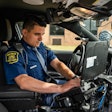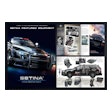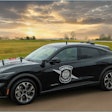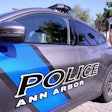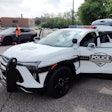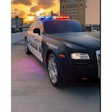The number of safety features offered on automobiles sold to the general public today is astounding. Stroll through the showrooms of almost any dealership, and you’ll see new cars that have anti-lock brakes, air bags, carefully engineered crumple zones, stronger frames, and much more.
But do police duty vehicles, with their unique requirements, get those same safety features or do budgetary constraints make them impractical? Or are there other safety features incorporated into police cars that may not be offered on civilian vehicles?
Patrol vehicles, of course, see far more use than nearly any other passenger vehicle except for, perhaps, taxis. Thus, keeping a fleet (however large or small) of police cars running demands something that is a bit more robust than the average consumer is going to choose from the dealer’s showroom floor.
Besides having to endure near-constant operation, a police patrol vehicle is often subjected to such stresses as far more intensive and extensive acceleration/deceleration cycles, to-the-limit cornering, and even intentional collisions. A cop’s vehicle must perform upon demand, and it must keep him or her safe while doing so.
But while many of the mechanical systems and features of current vehicles provide added safety, it must be noted that the driving training police officers receive is just as important. After all, while it’s outstanding to survive a crash, it’s even better to avoid one in the first place, and that’s where good training and situational awareness feature heavily. As one former deputy observes, "The safety area I feel is most important is education and training for the troops to keep them out of wrecks."
But carmakers and their design teams play a role in officer safety as well. Let’s take a look at what the Big 3 American police car manufacturers are doing to make their cars safer for the nation’s law enforcement personnel.
Chevrolet
Offered as a police pursuit vehicle since its introduction in 1999, the Chevrolet 9C1 Impala Police Package is unique among police models from any manufacturer employed in that role domestically. You see, it’s not just a spin-off of the civilian Impala; it was designed concurrently for both police duty and as a civilian model. That means that all safety features available in the civilian Impala are also available in the Police Package Impala.
A front-wheel-drive patrol car, the Impala features a 3.8-liter cast iron V-6 rated at 200 horsepower at 5200 rpm mated to a four-speed automatic transmission with overdrive. It can go faster, but it’s artificially limited to a 129-mph top speed by a fuel cutoff. Aside from upgrades to the four-wheel independent suspension (heavy-duty stabilizer bars fore and aft, reinforced front struts, revised spring rates, and shock valving, among other items), the Impala Police Package also includes a high-output alternator and both engine and transaxle oil coolers.
The primary safety features include police-calibrated four-wheel ABS with heavy-duty front pads (Chevy proudly points out the Impala’s shorter stopping distances from 60 mph than its competitors), driver and front passenger air bags, and driver’s side-impact air bag.
Some applications simply demand a large V-8-powered, rear-wheel-drive vehicle, though, and in response to requests from various agencies, Chevy is now offering a Police Tahoe that’s certified for high-speed and severe-duty law enforcement use. That makes it substantially different than the current Special Service Tahoe, which is not high-speed rated.
"The market feels that today’s conventional sedan that’s currently out there doesn’t fit the bill for a number of reasons: the ability to package equipment, the versatility, the longevity, the durability," says Bruce Wiley, General Motors Law Enforcement/Specialty Vehicle Program Manager. "A large county [and] some very large cities are looking to use [the Police Tahoe] as an alternative to the conventional sedan because of the versatility and capabilities," he adds.
And make no mistake, this is not a stock Tahoe. "We have gone through and we have extensively evaluated the ride and handling capabilities. We’ve made modifications to the trim height of the car, lowered the center of gravity—things that we discussed on the Impala, similar considerations are being given to the Tahoe. It’ll have larger stabilizer bars on it for improved ride and handling, different brake lining material, different cooling system, different shocks, shock valving, adjustment in the torsion bars," Wiley says.
As for its safety features, Wiley says the Police Tahoe will have "the same [equipment] that you would find in a retail vehicle. It has all the air bag systems that are available to the product."
Dodge
The Dodge Intrepid is the newest offering to police departments looking for pursuit vehicles, and with its ties to NASCAR, pursuit is a role the Intrepid fills ably.
First introduced to police agencies at the beginning of 2002, the Intrepid boasts a 242-horsepower, 24-valve 3.5-liter V-6 with a four-speed automatic transmission, and it is clean and efficient enough to earn a Low Emission Vehicle rating. The Intrepid is a front-wheel-drive car with a 17.2-gallon fuel tank mounted mid-ship. Testing by the Michigan State Police earlier this year proved it to be the fastest of the patrol cars offered by the “Big Three” from Detroit with a 136-mph confirmed top speed.
Police-bound Intrepids come with heavy-duty suspension (independent front and rear) and brakes. Part of the police package, in fact, includes NASCAR-inspired ducts to channel cool air onto the four disc brakes. Also different from the civilian Intrepid is the police-specific front seat with a low bolster to help prevent an officer’s handgun from digging into his or her waist. Auxiliary coolers help engine oil, transmission fluid, and power steering fluid remain at safe temperature levels. In addition, V-rated tires (meaning the tires are rated to be safe at 149 miles per hour) are part of the package.
The Intrepid’s safety features fall in line with its competitors—ABS and air bags for both driver and passenger. In addition, supplemental side air bags are offered as an option; these protect the front and rear outboard cabin occupants.
Ford
Ford’s Crown Victoria Police Interceptor is to patrol vehicles what McDonald’s is to fast food joints: It’s everywhere.
Introduced in its original body style in 1978 and with a reported 85 percent of the U.S. police car market, the Crown Vic is undeniably popular with departments everywhere. (Its reliability and size also make it a hit as a taxi, especially in New York City, where 94 percent of the taxi fleets are comprised of Crown Vics that operate nearly 24 hours a day and accumulate approximately 85,000 miles a year each.)
A full-size sedan with rear-wheel drive and a single overhead cam (SOHC) iron block/aluminum head 4.6-liter V-8 producing 235 horsepower, the Police Interceptor follows the classic cop car mold in one sense, but it’s also a very modern car that’s even rated as a Low Emission Vehicle (LEV) for the environmentally concerned. (In addition, Ford offers a dedicated natural gas version that’s cleaner burning and garners an Ultra-Low Emission Vehicle [ULEV] rating.)
Crown Vic Police Interceptors have four-speed automatic transmissions that sport auxiliary coolers to go with the enhanced engine cooling systems. It also comes with speed-rated Goodyear Eagle RS-A Plus tires that are better suited to the sometimes higher-speed operations inherent in police work.
The 2003 Police Interceptor inherited the revised frame of the civilian model, featuring hydro-formed front rails with a large crumple zone. The Crown Vic is also the only remaining rear-wheel-drive sedan in general use as a pursuit vehicle, with the added distinction of being the sole offering to have body-on-frame construction. This is widely believed to provide more occupant protection in crashes, as the heavy frame structure helps prevent intrusion to a much greater degree than the sheet metal of the body can.
Additional safety equipment on the Police Interceptor includes Ford’s Personal Safety System, comprised of dual-stage front air bags (which deploy according to crash severity, safety belt usage and the driver’s seat position relative to the steering wheel), safety belt pre-tensioners, and energy management retractors. There are also new side crash beams for all four doors and optional seat-mounted outboard side air bags for the front seats.
The Crown Vic also boasts four-wheel ABS for its four disc brakes, and Ford’s Electronic Brakeforce Distribution (EBD) system now optimizes the front-to-rear brake bias. There’s also a dual-rate brake booster with "panic assist" that automatically provides full braking power even if the driver fails to initially hit the pedal hard enough to activate the standard ABS circuit. And the Police Interceptor gets heavy-duty brake pads and suspension, plus a steering system that provides more road feel than the consumer model.
"From a safety standpoint, I don’t think there are any differences that are unique [in the Police Interceptor]," Ford Police Vehicle Specialist Michael Blackmer says. "Most of the differences between the [civilian and the police Crown Vics] are going to be for durability and performance."









